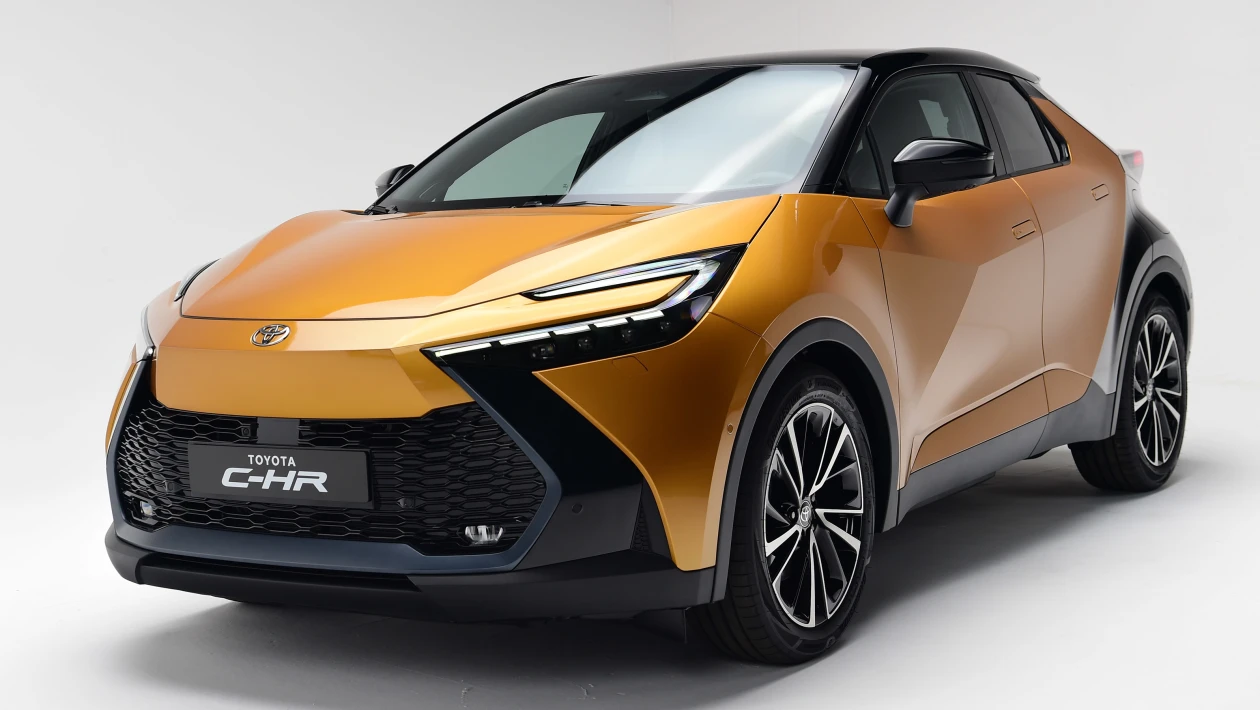
The second-generation Toyota C-HR SUV has been revealed with sharper styling and a choice of hybrid powertrains.
The new ‘Coupe High-Rider’ Toyota C-HR has been revealed with full hybrid and plug-in hybrid powertrains on offer, plus Toyota’s latest infotainment tech and more space and practicality than the car it replaces. Not to mention a sharper, more striking look.
it will arrive in Australia next year as a hybrid only.

This second-generation C-HR takes styling inspiration from the latest Prius and features C-shaped LED running lights and a two-tone front bumper insert lower down. This contrasting black body colour is continued down the car’s flanks, kicking up behind the rear doors to reinterpret the C-HR’s trademark C-pillar kinks. There’s a neat dual-element rear spoiler at the top of the heavily raked tailgate, with a full-width LED light bar spanning the boot lid. When illuminated, this shows the ‘C-HR’ moniker.
The production-ready C-HR’s styling remains faithful to the design of the C-HR Prologue concept, with the smoother, more curvaceous curves of Toyota’s original, almost coupe-like compact SUV (which made its debut in 2016) replaced by sharp lines and solid surfacing. There’s also a family resemblance to Toyota’s smaller crossover for the city, the Aygo X, with both cars featuring a two-tone body and C-pillar treatment.
Unlike the previous C-HR, this new car is available with both full-hybrid and plug-in hybrid powertrains. The former are familiar set-ups and use either a 1.8 or 2.0-litre four-cylinder petrol engine that’s complimented by a compact battery and an electric motor. The two hybrids are based on Toyota’s latest fifth-generation set-up. The latter will also be available as an all-wheel-drive AWD-i model that features an electric motor on the rear axle.
Toyota says that the C-HR PHEV features a “one-pedal-like driving experience”, thanks to a new feature called Regeneration Boost that offers three levels of brake regen to choose from. The car will also adjust the drive automatically for maximum energy recuperation when following a route in the car’s sat-nav. The nav set-up also features geofencing tech, so the C-HR PHEV can automatically select EV mode when entering a low-emissions zone.
Inside, the new C-HR features a heavily revised interior, including a new infotainment set-up that offers a 12.3-inch digital dash (depending on spec). Again, depending on the trim level, the main 12.3-inch infotainment screen features Apple CarPlay and Android Auto connectivity, as well as features such a charging station locations in the PHEV, while owners can customise the set-up and the interior with 64 colours for the ambient interior lighting and a programme with 24 changing shades that alter as each hour of the day passes.
Another key piece of connectivity is Toyota’s digital key system, expected in 2024, which will allow owners to unlock and start their car using their mobile phone. There will also be a new remote parking app, with users able to manoeuvre the vehicle from outside the car.
Toyota says that it has also boosted practicality, with feeling of space inside improved over the previous-generation car, which was known to be tight in the rear. We sat in a car at the launch and can confirm this is true, with fair legroom but still slightly limited access to the rear seats. The brand has not yet outlined boot capacities, but we’re told to expect an improvement over the outgoing car’s. Toyota sources say the compromise on luggage space in the PHEV is marginal, due to the location of the battery, beneath the C-HR’s floor in the centre of the car.
Many of the interior materials are made from recycled plastics, including new seat fabrics made entirely of used PET bottles. Other materials and features in the C-HR’s construction – such as the new fixed panoramic-roof design, which doesn’t need a sun shade, saving 5kg – help to save weight and boost efficiency, according to the brand. This has helped boost the car’s ride and handling, according to Toyota; the new C-HR has been engineered for Europe, in Europe, with tweaks to the TNGA platform’s suspension, brakes and steering to deliver a “fun-to-drive factor” and a balance with ride comfort.
There’s a haul of safety tech on offer too, with Toyota fitting a new Acceleration Suppression system that will avoid heavy throttle inputs when an object is detected ahead, plus Proactive Driving Assist tech that works at low speed when coming off the throttle, delivering progressive deceleration when cars are detected ahead of the vehicle. Depending on trim level, the usual Toyota Safety Sense suite of systems will be available, including lane assist, autonomous emergency braking, cross-traffic alert, a driver monitor and automatic high beam, among other features.
The regular trim range and pricing have yet to be confirmed, but given the increase in tech and space, expect the entry-level Hybrid’s price to rise.




